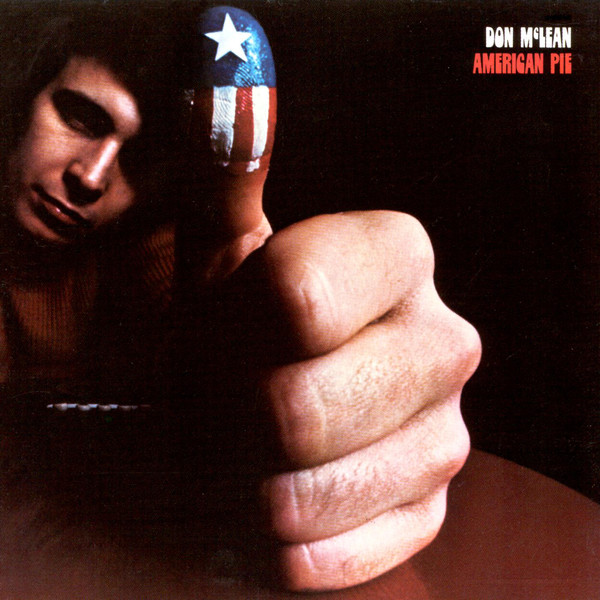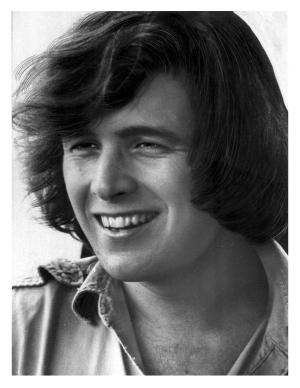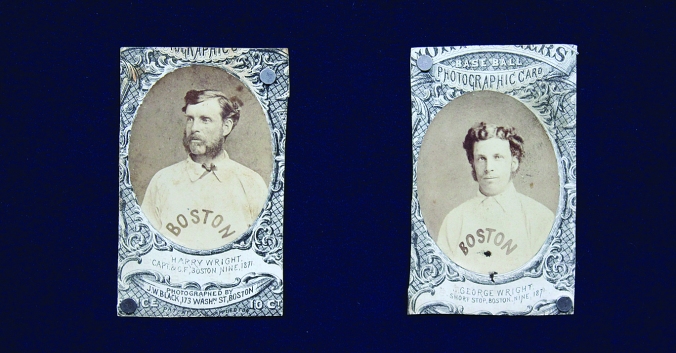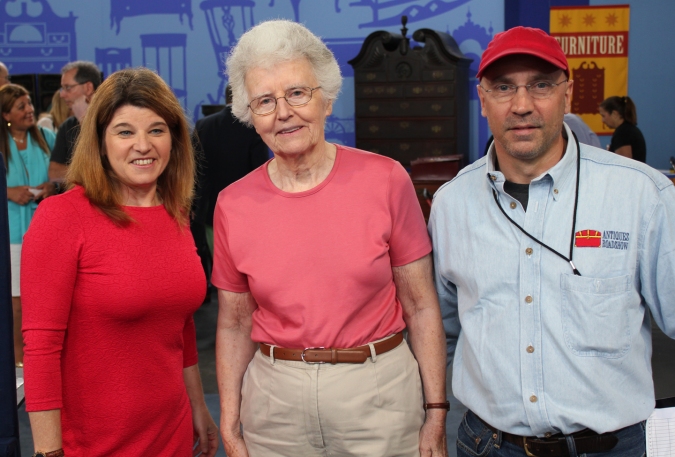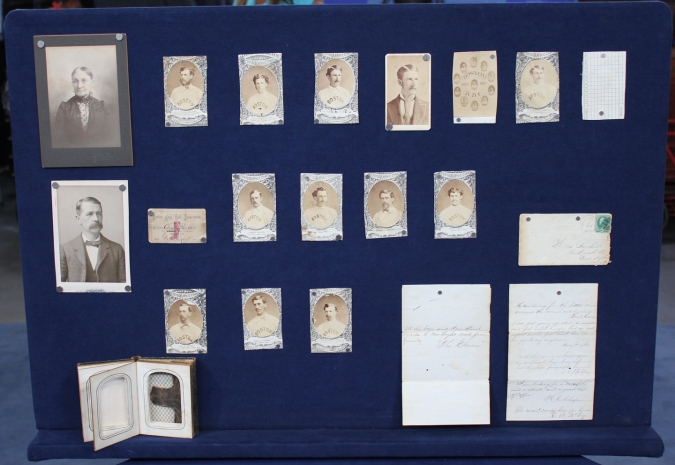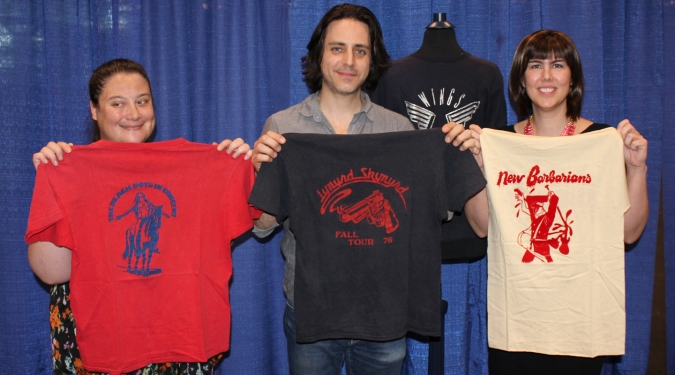
Jason Sprinzen is flanked by his friend Carrie (left, holding a Beach Boys T-shirt) and appraiser Laura Woolley (holding a New Barbarians shirt). Displayed behind them is a Paul McCartney & Wings T-shirt. Sprinzen’s unique collection of 165 rare Showco-branded shirts has surprising value.
In 2007, Jason Sprinzen bought a Led Zeppelin T-shirt at Christie’s for $1,625 — pricey, but the garment had rarity on its side. It was part of a small run of Zeppelin T-shirts made by Showco (a pioneer in the world of arena-rock audio production) for its crew members and for the artists they served.
Today, the four-figure price feels like a steal: It sent Sprinzen on a passionate pursuit for now-valuable Showco shirts (more on that in a minute). Along the way, he’s become an authority on the subject: where they came from, what they look like, who wore them.
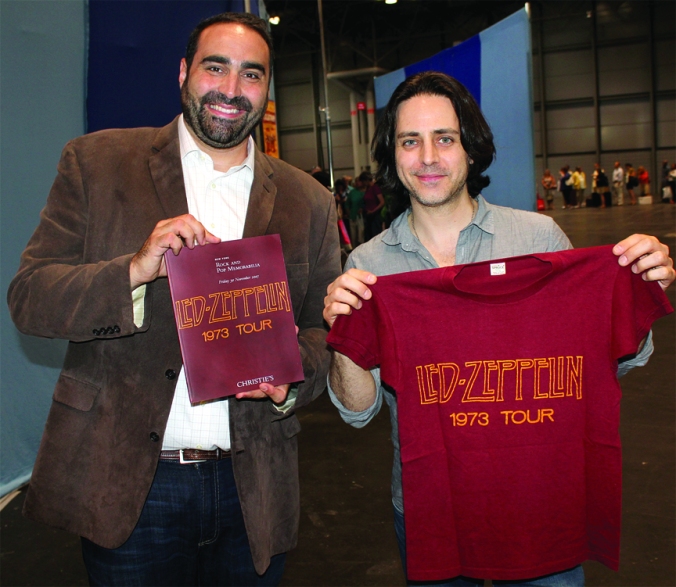
Appraiser Simeon Lipman (left) and Jason Sprinzen display the same Led Zeppelin T-shirt that once graced the cover of a Christie’s catalog. Sprinzen bought the T from Christie’s — and Lipman once worked in the Collectibles department at Christie’s.
I got a look at Sprinzen’s collection at Antiques Roadshow‘s New York event in August 2014 and recently followed up with him. Clearly, his collecting niche is as tightly focused as a hobby can be, and it’s populated by relatively few serious collectors. These factors made it easy for Sprinzen, during his first few years as a Showco hunter, to acquire worthy pieces at bargain prices.
Among his early finds: a Showco T-shirt originally owned by Ronnie Van Zant, the ill-fated lead singer of Lynyrd Skynrd. (Van Zant and two other members of the band died in a 1977 plane crash. Lynyrd Skynyrd later re-formed, with Ronnie’s younger brother Johnny Van Zant as lead vocalist, and continues to tour today; see http://lynyrdskynyrd.com.)
If there’s a holy grail in this hobby, the Ronnie Van Zant shirt is a major contender. “I purchased it a few years back from Joe Barnes, who was the second roadie hired in 1973 to work for Lynyrd Skynyrd,” Sprinzen says. “This was Ronnie’s favorite shirt. If you do a search [online], you’ll see him wearing it on and off stage more than any other he owned.”
THE COLLECTION: When I met Sprinzen, he had 163 other Showco T-shirts besides the Zeppelin and Van Zant rarities. Since then, he has added a half-dozen more. “In my lifetime, I’ll never be able to collect every one that was ever produced,” he says (see “The Showco T-Shirt Universe” below). “In a way that’s unfortunate. However, it’s the hunt — worldwide — to uncover the undocumented examples that does it for me.”
His hobby has inspired him to write a book that will depict and describe every piece in his collection. He’s calling it Showco: The Book/10,000 Nights on the Road, and he’s given it a Facebook page (https://www.facebook.com/ShowcoTheBook) to keep fellow collectors informed.
THE PERFORMERS: Showco T-shirts, Sprinzen said, “were never made available commercially” — an important point. It means not only that there was a small run, but that virtually every one he owns likely was “there at a concert.” If they could tell stories, music fans would listen. Consider the names on the T-shirts in Sprinzen’s stash:
• Music legends Paul McCartney & Wings, the Beach Boys, the Rolling Stones, and the Who, Eric Clapton, and Electric Light Orchestra.
• Chart-topping family acts the Bee Gees, the Jacksons, and the Osmonds.
• Soft-rock stars Bread, the Carpenters, and James Taylor
• Mainstream pop/rock artists David Bowie, Jackson Browne, Steve Miller, and Linda Ronstadt.
• Hard-edged rockers Black Sabbath, Boston, Alice Cooper, and Van Halen.
• A little bit of country (Willie Nelson) and some funk-rock (Lionel Richie’s band The Commodores).
THE APPRAISAL: At Antiques Roadshow, appraisers Laura Woolley, Grant Zahajko, and Simeon Lipman were excited by Sprinzen’s rock’n’roll treasures. The key to the collection, they agreed: a disciplined approach. As Sprinzen pointed out, “It’s very focused — Showco shirts only — and covers the years 1970–1981.”
Woolley drove home that point. “By putting all those ‘eggs in a basket,’” she said, “his hobby turned into a creative — and valuable — collection.”
How valuable? Many of them would sell for $200–$300 at auction today; others would push well beyond that. And those rare Led Zeppelin and Ronnie Van Zant shirts? They’d bring several thousand dollars each.
Woolley’s final assessment: an estimate of $8,000 combined for the Zeppelin and Van Zant shirts, and around $400 each for the other 163 T-shirts. Do the math, and the grand total is $73,200.
“That’s crazy,” said Sprinzen, himself a musician who has played guitar for many years. “I’ve never really thought about the value of the whole collection.”
 HOW MANY Ts?: So how big is the universe of Showco T-shirts? “The exact total of how many different T-shirts were made isn’t known, and may never be known,” Sprinzen says. “While they were being made from 1970–1985, no one— meaning the manufacturer and the Showco employees — ever documented the number produced. To them, they were just really nice quality and comfortable work shirts. Who would have thought they’d take on this ‘iconic’ status?”
HOW MANY Ts?: So how big is the universe of Showco T-shirts? “The exact total of how many different T-shirts were made isn’t known, and may never be known,” Sprinzen says. “While they were being made from 1970–1985, no one— meaning the manufacturer and the Showco employees — ever documented the number produced. To them, they were just really nice quality and comfortable work shirts. Who would have thought they’d take on this ‘iconic’ status?”
“To make a long story short,” he continues, “I have documented 253 examples — ones I personally own and ones I have seen in the collections of Showco alumni. My educated guess? There are perhaps more than 300–350 different examples.”
Yet he also points out that the shirts “were sometimes made in an infinite color combination, depending on how big and how long a tour may have been.” That fact makes it near-impossible to pinpoint the size of the Showco T-shirt universe. But he’ll keep searching, using a variety of sources. “I’ve bought some shirts on eBay,” he says, “and sometimes I get them directly from roadies.”
ABOUT SHOWCO: Showco, launched near Dallas in 1970, provided audio services at arena-sized concerts. Co-founder Rusty Brutsche once described the company’s mission as such: “We were one of the first to realize the amount and scale of equipment that the major arena concerts required. Jack [Maxson] was a recording engineer and I was a musician. We learned that most public address systems were built for the amplification of a single announcer over crowd noise. The dynamics of live music and the power required to generate the sounds we hear at concerts today were almost unthinkable at that time.”
So if you attended concerts in the 1970s and 1980s, you likely experienced Showco sound. Now… you need the T.
